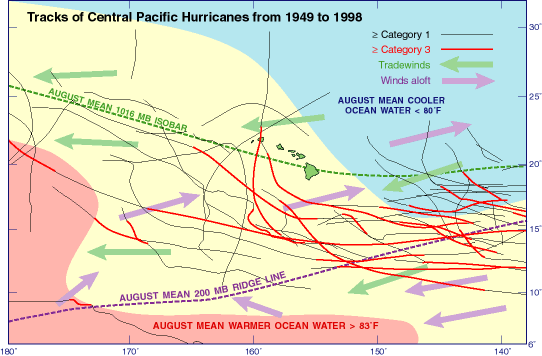Yesterday, Tropical Depression Flossie passed over Maui. What was once a strong tropical storm with sustained wind gusts of 60 miles per hour, rapidly deteriorated over a period of 18 hours. The storm felt the impact of high level winds that helped to break apart the circulation of the storm. Flossie still had enough juice when it crossed Maui to bring one of the biggest thunderstorms I have seen since I have lived on island. You can get a taste for Flossie’s thunder and lightning in this short clip from the peak of the storm.
For those of you who have never lived in Hawaii, you may be wondering about the impact of Hurricanes on the islands. Formal records on Hurricanes in Hawaii started in 1950. Since the Fifties, there have been 45 tropical depressions, storms or hurricanes that have approached the vicinity of the Hawaiian Islands. The storms usually originate in the Eastern Pacific off the coast of Mexico. As they traveled West towards Hawaii, many of the storms grew into significant Hurricanes only to dissipate quickly as they approach the islands. A good example of that is Hurricane Flossie which approached within a few hundred miles of the Big Island in 2007 as a Category Four Hurricane. It quickly weakened into a Tropical Storm within 24 hours. High level winds and cooler waters to our East have been contributing factors as to why Hurricanes tend to dissipate close to Hawaii. Some have surmised that the Big Island’s massive volcanoes somehow also play a role in weakening tropical systems approaching from the east. I haven’t seen any firm data to support that assertion other than the fact that mountains can weaken storms that make landfall.

While most Hurricanes lose steam before they get to Hawaii, there have been some that have had more significant impact on the islands. Hurricane Iniki had a direct hit on Kauai in 1992. It was a devastating storm that did approximately Two Billion Dollars in damages. Even diminished storms can have an impact bringing dangerous surf, gusty winds, electrical storms and flash flooding. Residents and visitors should always take precautions when a storm approaches the islands. Here are some important to dos when preparing for a potential tropical storm:
- Prepare an Emergency Supply Kit well in advance of the storms arrival.
- Prepare your house for the impact of a storm
- Fuel your vehicles. Storm damage could disrupt the supply of gas coming to service stations.
- Get your storm information from good resources. I saw lots of amateur weathermen taking to social media yesterday morning saying the storm was a complete non-event because it wasn’t raining in the morning. Flossie may have lost some strength but she still wasn’t supposed to have had an impact until the afternoon. That made for some surprises when the afternoon thunderstorms struck Maui. The Central Pacific Hurricane Center is your best resource for complete forecast information.
While Hawaii is not nearly as vulnerable to Hurricanes as the Gulf and Atlantic coast of the mainland, Hawaii residents should always be prepared for the worst and hope for the best. Of note from a real estate perspective, many lenders require Hurricane Insurance with a home or condo purchase in Hawaii. Even if you are a cash buyer for a property, Hurricane Insurance is not a bad a idea. It makes sense to at least review your basic homeowner’s policies to see if you have sufficient coverage in the event of flood, storm surge and wind related damages.

